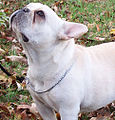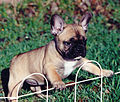New Rules for UK Breeders
The Kennel Club of England has announced new rules for UK breeders, starting in 2012.
From a November 22cnd news release on their website:
The Kennel Club has announced that from 2012 it will normally register no more than four litters from any one bitch because of concerns that the current legal limit of six litters can potentially be detrimental to a bitch’s welfare.
The decision was made by the Kennel Club General Committee after receiving a recommendation from its Dog Health Group and will be effective for litters born on or after 1st January 2012.
Six litters per bitch is the current legal limit enshrined in the Breeding and Sale of Dogs (Welfare) Act 1999.
Bill Lambert, the Kennel Club’s Health and Breeder Services Manager, said: “The Kennel Club wants to ensure that all breeders put the health and welfare of their puppies and breeding bitches first and foremost, and this decision underlines our commitment to this issue.
“Whilst the law allows bitches to have six litters in a lifetime and our registration system has previously fallen in line with this, the vast majority of responsible breeders feel that this is too high and that there is potential for this to have a negative impact on the welfare of the bitch.
“Very serious consideration has to be given to the matter if a breeder wishes a bitch to have more than four litters but the Kennel Club may grant permission for this to happen if it believes that there is good and justifiable reason for doing so on a case by case basis.”
There are also new restrictions on Caesarian Sections for bitches in the UK.
Excerpt from the news release:
The Kennel Club has had discussions with the major veterinary organisations over restrictions on the number of litters born by caesarean section which may be registered from an individual bitch from 2012.
The Kennel Club has confirmed that it will no longer register any puppies born by caesarean section from any bitch which has previously had two such operations, except for scientifically proven welfare reasons and in such cases normally provided that the application is made prior to mating. Refusal to register a third or subsequent litters of puppies born by caesarean section would occur irrespective of whether the progeny from either of the first two operations had been registered with the Club.
Following discussions with the Royal College of Veterinary Surgeons, the British Veterinary Association and the British Small Animal Veterinary Association, the organisations have agreed to advise their members that any caesarean sections which they perform on a Kennel Club registered bitch should be reported to the Kennel Club.
To allow the reporting of such operations by veterinary surgeons, an additional section will be incorporated into the form which is presently completed to notify the Kennel Club of any operation which alters the natural conformation of a registered pedigree dog.
This policy will become effective for all litters born on or after 1st January 2012. Further details relating to the timing of reporting by veterinary surgeons will be announced in due course.
In essence, bitches may have no more than 2 c section deliveries “except for scientifically proven welfare reasons and in such cases normally provided that the application is made prior to mating.”
No one seems to have any idea what defines a “scientifically proven welfare reason” is, or if it will be allowed to be applied to French Bulldogs.
As more and more countries move towards restrictions on routine c sections, it behooves us as breeders to begin breeding intentionally for dogs with the ability to free whelp. I believe that many of our North American bitches could, if allowed, actually free whelp, but fear of complications or uterine inertia causes many of us to consider c sections to be an unavoidable reality.
As someone who has lost a puppy due to uterine inertia, and has also had several successfully free whelped litters, I agree that it’s a hard call to make. C sections are horribly invasive procedures, with copious risks to both bitch and puppies, and yet it’s also true that many puppies have died due to a bitch’s inability to deliver them naturally.
As I said, tough call.
















